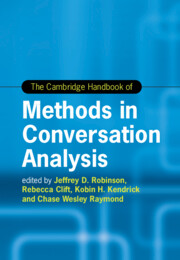Book contents
- Frontmatter
- Contents
- List of Tables
- List of Contributors
- Part I Introduction
- Part II Points of Departure
- Part III Collections
- Part IV Evidence
- 13 Evidencing Conversation-Analytic Claims: How Participants Orient to Social Action
- 14 Evidence for Claims about Interactants’ Sense-Making Processes
- 15 Conversation Analysis as a Comparative Methodology
- 16 The Epistemics of Epistemics: Validating Claims about Epistemic Stance in Conversation Analysis
- 17 Coding and Statistically Associating Inter-Action to Advance Conversation-Analytic Findings
- Part V Avenues into Action
- Part VI Situating and Reporting Findings
- Part VII Looking Forward
- Appendix I Jeffersonian Transcription Conventions
- Appendix II Multimodal Transcription Conventions
- Index
13 - Evidencing Conversation-Analytic Claims: How Participants Orient to Social Action
from Part IV - Evidence
Published online by Cambridge University Press: 06 December 2024
- Frontmatter
- Contents
- List of Tables
- List of Contributors
- Part I Introduction
- Part II Points of Departure
- Part III Collections
- Part IV Evidence
- 13 Evidencing Conversation-Analytic Claims: How Participants Orient to Social Action
- 14 Evidence for Claims about Interactants’ Sense-Making Processes
- 15 Conversation Analysis as a Comparative Methodology
- 16 The Epistemics of Epistemics: Validating Claims about Epistemic Stance in Conversation Analysis
- 17 Coding and Statistically Associating Inter-Action to Advance Conversation-Analytic Findings
- Part V Avenues into Action
- Part VI Situating and Reporting Findings
- Part VII Looking Forward
- Appendix I Jeffersonian Transcription Conventions
- Appendix II Multimodal Transcription Conventions
- Index
Summary
This chapter discusses different types of evidence that conversation analysts use to ground their claims about social action. We begin by reviewing the epistemological perspective of CA, which demands that evidence reflect participants’ orientations; as a critical part of understanding the terms ‘participant orientation’ and ‘relevance,’ here we also discuss two ways in which CA’s position and emphasis on them are commonly misunderstood. The bulk of this chapter then reviews and illustrates a range of types of participant-orientation evidence. We organize our presentation of types of evidence roughly by sequential position vis-à-vis the focal action about which the analyst is making claims, including evidence to be found in: (i) next-turn, (ii) same-turn (e.g., same-TCU self-repair, accounts), (iii) prior turn or sequence, (iv) third turn/position (e.g., repair after next turn, courses of action/activity), (v) fourth turn/position, and (vi) more distal positions. We also discuss other forms of evidence that are not necessarily defined by sequential position, including: (i) third-party conduct, (ii) reported conduct, (iii) deviant cases, and (iv) distributional evidence. We conclude by offering some brief reflections on bringing different types and positions of evidence together toward the construction of an argument.
Keywords
- Type
- Chapter
- Information
- The Cambridge Handbook of Methods in Conversation Analysis , pp. 315 - 355Publisher: Cambridge University PressPrint publication year: 2024

